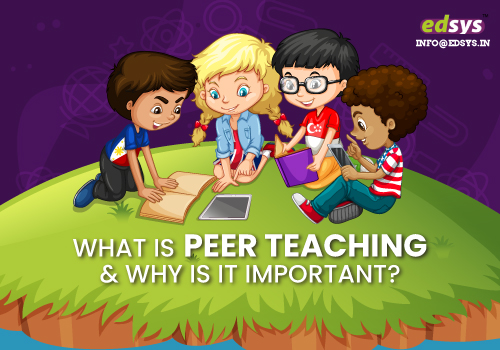Peer teaching is one of the best ways to master a particular subject. It is a method of teaching, where a student instructs another student, wherein the former will be an expert and the latter a novice.
This paves the learner student to learn without depending upon the teacher, and the teacher-student to revise the topic again, on the belief that “To teach is to learn twice”(Collins).
Access Here More Than 1000+ FREE Educational Apps
Through the direct interaction between students, peer teaching promotes active learning as well as participation within themselves. Student teachers enhance their own depth of knowledge in the topic by instructing others.
Benefits of Peer Teaching
Peer teaching is not a novel concept, as it was seen right from the time when the system of Gurukula education prevailed in our society.
Since then, it was an effective method of teaching as well as learning. And now, peer teaching is quite popular among students of all ages.
Here are some of the Main Benefits of Peer Teaching:
- It enhances the student’s level of creativity in expressing ideas as well as in grabbing new concepts, as the student may not feel hesitant to clear his queries. This will also uplift his knowledge limit and thus allow a greater level of his understanding. Feeling at ease with a peer tutor, allows a student to concentrate better on the tasks of the lesson, which may transfer into higher achievements in the future. To an extent, the student will start questioning his own doubts, and will later find a way to resolve it himself, which will enable the student to improve his critical thinking.
- Peer Teaching involves direct interaction between the learner student and the teacher-student, this will help them to promote the active learning along with interpersonal skills, with which they can actually bid adieu to the so-called boring lectures and classes.
- It will ease the teacher’s burden of responsibility because she is sharing her duties with her kids which are beneficial to them. But on the other side, it will increase the teacher’s role in monitoring and administering the students.
Disadvantages of Peer teaching
1) Amateur student
In spite of the fact that the teacher shares her tips and guidelines with the students, it won’t build an expert teacher (student).
There are also chances of a communication gap within the student and the teacher, which may often lead to the failure of assigned activities.
2) The Reluctance of Students
The toughest responsibility that lies upon the shoulders of a teacher is the reluctance of students to initiate the assigned duty.
Just like the two sides of a coin, there may be students who are actually willing to teach and on the other side, there may be students who are hesitant to work out of their comfort zone. Hence, this becomes a challenge for the teacher.
3) Annoyed parents
When the parents come to know about peer teaching, there may be chances for them to misinterpret the concept of peer teaching.
Parents may take it in a derogative manner that their kid is being taught by some other kid of the same age and that the teacher is sitting idle.
So, there may be complaints from the side of the parents until and unless they are completely given the justification behind the concept of peer teaching.
Types of Peer Teaching
1) One way peer teaching
This way of peer teaching provides only the trained tutor to teach, whereas the child with some kind of disability will remain passive.
This method will be more useful for teaching students with severe disorders like autism, visual impairment or cerebral palsy.
Also Read: 16 Innovative Ideas to Make your Teaching Methods More Effective
The main merit of this method is that the teacher, as well as the student, will be well aware of their roles throughout the entire teaching and learning program
2) Duplex or reciprocal peer teaching
This is a two way or bidirectional teaching process where a student with a disability is paired with a student without disability to form a dyad (pair) and both of them will get chances to teach and learn.
This method is more useful to bring the activeness in children with moderate disabilities.
The main advantage of this method is that every individual will get a chance to play the role of a teacher as well as that of a student simultaneously.
3) Class-wide Peer Tutoring
This methodology of teaching involves grouping the entire class into pairs, and peers mentoring each other by giving prompts, error correction and helping each other.
This method is incomparable because every student is given cue cards for the task to keep them focused on the goal of the chapter and then the tutor takes the cue cards and marks the skills mastered by the particular student.
The main benefit of this approach is that no student is singled-out and that every student has to participate regardless of their disabilities
4) Crisscross or Cross-age peer tutoring
Cross-age peer teaching is a method of tutoring when children in different age groups and ability levels are paired together to work for a task.
The elder or the student with a higher level of intelligence will be assigned as the tutor whereas the other will be the tutee. This method will help them to improve their interpersonal skills too.
Access Here More Than 1000+ FREE Educational Apps
In short, peer teaching is all about teaching peers and learning from their peers, which involves learners and teachers of the same or different, age groups or levels of intelligence. This assisted teaching helps the students to enhance their teaching skills. In addition to this, they get a platform to perform what they know which will pave them to drive away from the stage fear within themselves.


